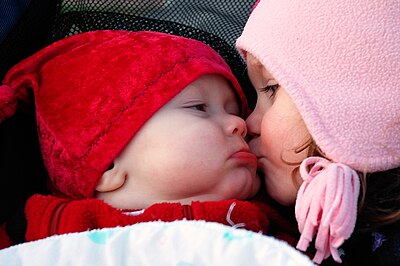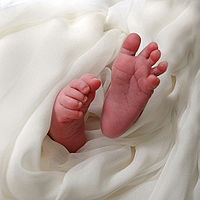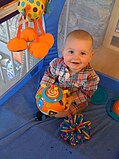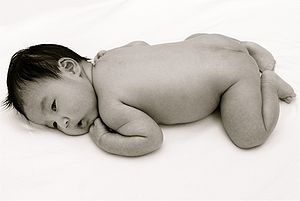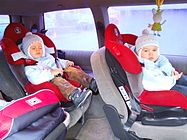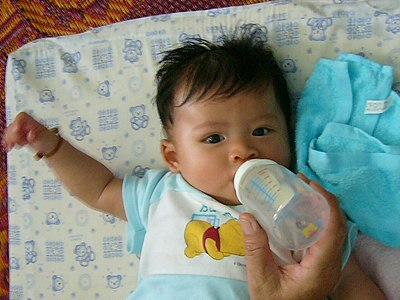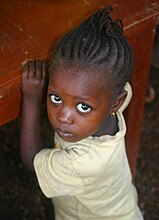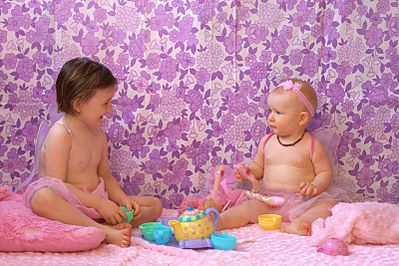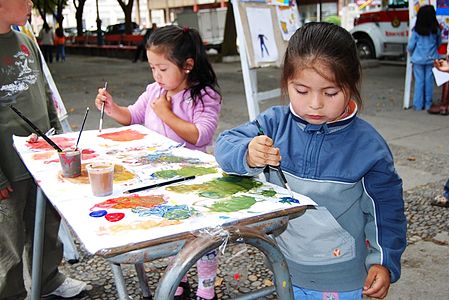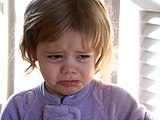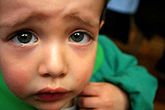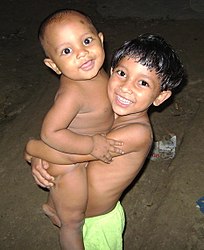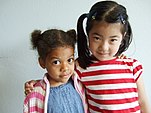Introducing New Baby to Siblings
Contents
Goal
To provide parents with tools and resources to successfully introduce the new baby to his/her "Big Brother" or "Big Sister."
By the end of this lesson, the learner will be able to:
|
Introduction
Integrating a new baby into the family structure changes the family dynamic. Often when there are other young children in the home, especially a first-born child or an only child, there can be feelings of jealousy, anger, and confusion when a new sibling arrives and all of the attention is suddenly focused on "the baby". This can be stressful for parents as well as the older child. Therefore, this page is designed to assist parents in helping their older child successfully transition to their new role as "Big Brother" or "Big Sister" in a healthy and fun manner.
Homecoming
One way to help your older child adjust to the birth of a new sibling is to involve the older child in the homecoming of the new baby. By emphasizing how special and unique the role of a big brother/big sister is, you are acknowledging your older child and helping him/her become excited about the new role. In addition, involving the older child in the homecoming of the new baby allows them to take on an active role in the new baby's homecoming.
There are numerous ways in which you can actively involve your child in the new baby's homecoming. Here are some suggestions:
- Let your older child come to the hospital with dad/partner to pick up mom and the new baby for the drive home.
- If your older child does not come to the hospital with Dad/partner to pick up mom and the new baby, have Dad/partner carry the new baby into the house so that mom's hands are free to immediately hug and greet the older child.
- Provide your older child with a special t-shirt or hat. This will help the new big brother/big sister feel included and important in the event and emphasize his/her new role.
- Give your older child a job or task that he/she can be responsible for during the new baby's homecoming. For example, have your older child be in charge of placing the blanket over the new baby in the car seat, or have your older child be in charge of opening and closing the car door for the new baby.
- Allow your older child to choose the outfit that the new baby will wear on the trip home from the hospital.
- Encourage your older child to give the new baby a tour of the house.
- As soon as the new baby is home, provide your child with a "thank you for being my big brother/big sister gift" from the new baby.
- Let your older child call friends and family members to announce the new baby.
- Send a special "Introducing the New Big Brother/Big Sister" email/mail announcement to friends and family.
- When visitors come to meet the new baby, request that they first greet your older child. Ask them to come down to the level of the older child and spend some time interacting with the older child before focusing attention on the new baby.
- Give your older child the responsibility of "Handwashing Police." Your older child can remind all visitors to wash their hands before touching or holding the new baby and can show visitors where to wash their hands.
- If visitors will be bringing gifts for the new baby, request that they bring two gifts: a special big brother/big sister gift for the older child and a gift for the new baby.
- Allow your older child to help unwrap the new baby gifts.
- Provide "I'm a big brother/big sister" treats such as color coordinated candy bars for your older child to pass around to friends, family members, or neighbors.
- Get in the habit of calling the new baby, "our baby" instead of "my baby".
Fun With New Baby
Create & Color a "Sibling Scrapbook"
Create a coloring book with your child with captions that help explain life with new baby. Engage your child in coloring in the pictures. Some possible captions might be:
- Here is a picture of me and new baby.
- Here is a picture of me helping Daddy change new baby's diaper.
- Here is me telling new baby a story about our dog Ben.
- Here is me eating ice cream. Babies can't eat ice cream because they are too little. What are some other things big brothers and sisters can eat than new baby can not?
- Here is me helping Mommy give new baby a bath.
- Here is me reading my favorite book to new baby.
- Here I am washing my hands before helping Mommy with new baby.
- Draw and color a picture of Mommy and Daddy and you with new baby.
You can either create and color your own "Sibling Scrapbook", or you can order one pre-made or in ebook format. For more information, see the "Resources" section.
Play "Pictures of Me & Pictures of Baby"
Allow your child to go through old photos to find pictures of themself and have them engage in dialogue about the photo. Possible questions might include:
- Is a baby big or little? Are you big or little?
- What are you wearing in that picture?
- What are you doing? (ie "sleeping") Why do you think babies sleep so much?
- What do babies do? Do they use the toliet like grown-ups or big kids?
- What do big kids do that babies can not?
- Why is baby wrapped in a blanket?
- Babies make funny faces. Can you show me some of the funny faces? Can you make some funny faces with me to make baby laugh?
- What kind of noises do babies make? What does it sound like... Can you show me?
Spark their Creativity by Letting them Play Decorator & Fashion Designer:
- Invite your child to help you make decisions about the baby's room or help pick out furniture or supplies. You can ask questions such as, "Where do you think we should put the rocking chair?" "Which blanket do you like better, the one with the bunnies or the one with the flowers?"
- Ask your child's advice on picking out clothes for the new baby, "Do you think new baby would like to wear the blue shirt today or the green one?"
Involve them in Baby Duty:
- Give them a new stuffed animal or doll that they can practice holding like a baby. You can also have them practice diapering & swaddling the doll as well.
- Let them help give new baby a bath. You can have them soap new baby's legs and pat new baby dry.
- Let them be in charge of getting out the new diaper when its time to change new baby.
- When new baby cries, ask the sibling to gently pat its back or find the pacifier.
- If the older sibling wants to hold the new baby you can have them sit in a chair with pillows on either side of her, and then prop the baby in her lap while you are right there to supervise.
Take a Field Trip:
- If you have a pre-schooler, plan a day to bring new baby to school so that they can show off their new baby. Have them wear a "I am a Big Brother/Sister" hat or t-shirt to emphasize their special role in the family.
- If it isn't practical to bring new baby to school, have them bring in pictures, or create a scrapbook of them with new baby that they can take to school for show-and-tell.
Watch a Video Together: There are many Sesame Street videos about new baby and "Brothers and Sisters (See "Media" section for more videos)
- Sesame Street Brothers and Sisters (You Tube video), http://youtu.be/BcRzT0fcPCc
Read a Book or Play a Game:
- Reading children's books with your older child will help them understand what is happening in your family. See "Resources" section for a list of books.
- Play an on-line educational game with your child, or visit an interactive web site, that introduces sibling relationships. KidsHealth.org provides valuable resources:
http://kidshealth.org/kid/feeling/home_family/new_baby.html
- You and your child can create an on-line game together that answers questions about new baby and big brothers or sisters. A good web resource for on-line educational games is:
http://people.uncw.edu/ertzbergerj/all.html
Sibling Safety
Another important aspect of the introduction of a new sibling is educating your older child about baby safety. Older children may not understand that their new sibling is still a baby, so it is important to teach them the differences between older children and babies. Teaching your older child about basic newborn safety simply involves making them knowledgeable about the simple baby safety practices. Here are some suggestions for fun ways to impart this safety knowledge to your older child.
- Tell your older child stories about the mischievous/dangerous things that they used to get into when they were a baby. Not only will they love hearing stories about themselves, but this is also an easy way to teach your older child about baby safety.
- As you (mother/father) walk around the house completing household chores, invite your older child to follow you. During this time, point out and talk about all of the things that could be dangerous to the baby (i.e. a hot cup of water, hot stove/oven, swimming pool, tall countertop, small coins/toys, electrical outlets, dangling cords, sharp knives, etc.) Once you have familiarized your older child with some of the household dangers, play a fun game of “I Spy” and take turns looking for and guessing items that would be dangerous for the new baby.
- Talk about how babies eat different foods than older children. Teach your older child what is safe for babies to eat. Explain that they may not give food or candy to the baby. Teach them to never give the baby a bottle unless an adult says it is okay and an adult is there to help with the feeding.
- Teach your older child the dangers of climbing or trying to reach to see the baby. Explain that they could accidently knock over or tip the high chair/crib. Let them know that if they want to say hello to the baby or kiss the baby, that they should ask an adult for help.
- Teach your older child about germs and explain that it is important for them to always wash their hands before touching or holding the baby. You can also give your older child the responsibility of reminding everyone else who comes to visit the baby to wash their own hands as well.
- Teach your older child that a baby’s head is very sensitive because the bones in the baby’s head are not yet fully formed. Explain that it is very bad for them to bump their head. Explain to your older child that they may not pick up, hold, or carry the baby by themselves. Let them know if they want to hold the baby that they should ask an adult for help, and that they may only hold the baby if they are sitting down in a chair.
- In addition, teach your older child to be very gentle when touching the baby and to not poke the new baby’s eyes, ears, or head.
- Teach your older child to speak gently and softly when whenever he/she is around the baby, and to be especially quiet when the baby is sleeping. Also teach your older child not to bother or wake up the sleeping baby.
- If you are in the Unites States and your community is serviced by the 9-1-1 system, teach your older child how to dial 9-1-1 in the event of an emergency. Teaching your child the difference between what is an emergency, and what is not an emergency is the first step. You can do this with fun role playing activities. For example: 1) Pretend the baby sitter or mommy/daddy is unconscious 2) Pretend there is a fire 3) Pretend that a grandparent has fallen down the steps 4) Pretend something is wrong with the new baby & mommy needs big brother or big sister to call 9-1-1. It is also important to role-play NON-emergency situations with your child so that they learn to distinguish the differences. These might include: 1) Pretend the dog is lost 2) Pretend one child won't share their toys with another 3) Pretend the baby is crying.
You can get more practical tips as well as some interactive songs and games on this subject at: http://www.911forkids.com/
- Teach your older child to always ask an adult before giving the new baby a toy to play with because the new baby could easily choke on a “Big Kid Toy." Explain that babies can only play with large toys that they cannot fit inside their mouth. Teach your older child the differences between “Big Kid Toys” and “Baby Toys.” Here is an activity you can use to help your child distinguish “big kid toys” from “Baby Toys”
| Toy Test Tube
Directions: Provide your older child with an empty toilet paper roll and appropriate craft/decoration materials. Help your older child decorate the toilet paper roll however he/she desires to make their very own "Toy Test Tube." Once the toilet paper roll is decorated, have a "Toy Test." Ask your child to bring some of his/her favorite toys as well as some of the new baby's toys. See if the toy passes the "Toy Test." Have your child hold the toy next to or on top of the "Toy Test Tube". Now have your child try to drop the toy through the "Toy Test Tube". Explain that if the toy can fit inside the "Toy Test Tube," or can be dropped through it, that the baby could try to swallow the toy and end up choking. Explain that these types of toys are “Big Kid Toys” and must be kept away from the new baby. Next, give your child a “Baby Toy” and ask him/her to do the same thing using the "Toy Test Tube". Explain that baby toys are much bigger and do not contain any small pieces or parts that the baby could choke on. Remind your older child again, that they must always ask an adult before giving the new baby a toy to play with. And to use the "Toy Test Tube" for every toy.
|
Clearly, there are a lot of safety guidelines to teach your older child about the new baby. More than anything though, it is important to remind your older child will only be a baby for a little while, and that soon they will have a lifelong playmate and friend. Here is another kid-friendly activity you can do with your older child to teach them about sibling safety:
| Sibling Safety Rule List
Items needed:
Directions: Provide your older child with construction paper and appropriate craft/decoration materials. Ask your child to write and decorate a list of "Sibling Safety Rules." If your older child cannot write yet, have your child verbalize the rules to you and write them for your child. Then, allow your child to decorate the list. Once your child is done decorating the "Sibling Safety Rule List," hang it on the refrigerator or another obvious spot in the house, where your child will see it on a regular basis.
|
Dealing with Feelings
The arrival of a new baby is a time of adjustment for everyone, especially your older sibling. The arrival of a new baby may cause an older sibling to feel displaced, frustrated, angry, or even unloved. Sibling rivalry is a genuine concern as well. It is important for parents to provide a supportive environment that will minimize feelings of jealousy and help the older sibling to deal with feelings and feel loved and secure.
Below are some ideas for helping your older sibling manage and deal with their feelings surrounding the arrival of new baby:
- Give your child some colorful markers and paper, or popsicle sticks and black scratch paper, and have them draw how they feel.
- Have your child make up a story about how they feel and how they wish things were.
- Help your child choose music and make up a dance, or song, expressing how they feel.
Help Them Problem Solve:
- Create a special signal between you and your child that will allow them to express how they are feeling. You might say, "When you are feeling sad or lonely, what special signal will you give me so that I know how you are feeling?"
- Acknowledge their feelings and help them find resolutions. For instance, you might say, "I see that you are wishing we could have some cuddle time and its frustrating that baby is in my lap nursing. Well, I have one arm free... Get your favorite book and if you turn the pages, we can snuggle while I read."
- Instead of Mom saying that she is busy with the new baby, try saying, "Mommy's hands are busy right now, but I would love for you to come and help us."
Talk About Feelings in Fun Simple Ways:
- You can say, "Sometimes its not fun when baby comes," and have them express their emotions by showing them pictures and having them make faces with you. You can use pictures of happy faces, silly faces, and then move to angry faces, bored faces, etc. Have the child express which face they identify with most. There are several book such as, The Way I Feel" by Janan Cain that you can read together with your child. Check the "Resources" section for more suggestions on books that you can read with your child that will help them deal with their emotions.
Provide Plenty of "Mom Time":
- Take some time each day to do something with just the older child.
- Set up a time once a week for a "Mommy and Me Date"
- Pull out the older child's baby book and spend some time looking at it with them.
Be Prepared for Aggression:
- Your older child may feel jealous and may act by hugging baby too tightly, or pinching. Make it clear that trying to hurt baby is not acceptable (see Section on "Sibling Safety"), but encourage your older child to talk about their feelings of jealousy or anger.
- You can use tools like giving your older sibling a "time out" until they can handle their emotions.
- Never leave your older child alone with new baby.
Parent Resources
Helpful Books for Parents:
- Welcoming Your New Baby, by V. Lansky
- The Parent Child Connection, by A. Rincover
- The Second Child. Family Transition and Adjustment, by R.B. Stewart
- Siblings Without Rivalry, by Adele Faber and Elaine Mazlish
- The Way I Feel, by Janan Cain
- I'd Rather Have an Iguana, by Heidi Stetson Mario
- We have a Baby, by Cathryn Falwel
- The New Baby, by Fred Rogers
- Our New Baby, by Wendy Cheyette Lewison
- 101 Things to do with a Baby, by Jan Ormerod
- The New Baby at Your House, by Joanna Cole
- The Berenstain Bears' New Baby, by Stan and Jan Berenstain
- My Baby Brother, by Harriet Hains
- Mommy's Lap, by Ruth Horowitz and H. Sorensen
- Big Like Me, by Anna Grossnickle Hines
- Betsy's Baby Brother, by Gunilla Wolde
- Sibling Scrapbook (coloring book, by Color Me Well Publications, www.colormewell.com
Videos for Kids:
|
Specialty Items:
- To purchase "I'm a Big Brother/Big Sister" hats and t-shirts: http://www.cornerstorkbabygifts.com/sibling-gifts.aspx
- To purchase Sibling Birth Announcements: http://www.tinyprints.com/shop/sibling_birth_announcements.htm
- To purchase treats/candies announcing the new sibling: http://wrappedhersheys.com/Birth-Gifts-Announcements.cfm
Big Brother Big Sister Fun Zone
Educational Games:
Kids Health, http://kidshealth.org/kid/feeling/home_family/new_baby.html
University of North Carolina Wilmington, Watson School of Education, http://people.uncw.edu/ertzbergerj/all.html
Crafts and Things:
Make your own black scrach paper. Here's how: http://www.ehow.com/how_7298543_use-pencil-scratch-black-paper.html
Videos:
- Sesame Street (You Tube Video): Brothers and Sisters, http://youtu.be/BcRzT0fcPCc
- Sesame Street (You Tube video): Telly Interviews a Big Sister and Baby Brother, http://youtu.be/WGhh6eMx3QE
- Sesame Street (You Tube Video): Family Dance, http://youtu.be/fLLcIz6H2mw
- Sesame Street (You Tube Video): We Got a Brand New Baby, http://youtu.be/8f1hLc98aIM
- Sesame Street (You Tube Video): You're My Baby, http://youtu.be/r501NT3NYw4
References
Anderson, J. E. (2006, February). Sibling rivalry: when the family circle becomes a boxing ring. Contemporary Pediatrics, 23(2), 72-84.
Bartell, S. (2007, June). Saying Goodbye to the Only Child Bond. Newborn Connections,at California Pacific Medical Center, San Francisco, California, USA.
Bastable S. B. (2008). Nurse as educator: Principles of teaching and learning for nursing practice, 3rd ed. Jones and Bartlett Publishers.
Boynton, R.W, (1994). Common child-rearing concerns: Sibling rivalry. Manual of ambulatory pediatrics (pp. 170-173). Philadelphia: J.B Lippincott Company.
Davidson, M. R., London, M. L., & Wieland Ladewig, P. A. (2012). Siblings. In Old’s Maternal- Newborn Nursing and Women’s Health Across the Lifespan (9th ed., pp. 312-313). New York, New York: Pearson .
Global Children's Fund. Baby Safety for Siblings: Teaching Older Kids How to Treat a Baby. Accessed 11/21/2011 from: http://www.keepyourchildsafe.org/child-safety-book/sibling-baby-safety.html
Gorney, D. (2007, June). Sibling Rivalry; How to Help Your Child Welcome a New Sibling. Newborn Connections, at California Pacific Medical Center, San Franncisco, California, USA
Murphy, S.O. (1993). Siblings and the new baby: Changing perspectives. Journal of Pediatric Nursing, 8 (5), 277-288.
Plum, R. (2006). Talking to Your Child About the New Baby. Newborn Connections, at California Pacific Medical Center, San Francisco, California, USA
Sawicki, J. A. (1997). Sibling rivalry and the new baby: anticipatory guidance and management strategies. Pediatric Nursing, 23(3), 298-302
Sibling Scrapbook; An Activity Book for the New Big Brother/Big Sister. (2005). Plantation, Florida: Color Me Well Publications.
Suggestions for Preparing Your Child for the Birth of a Sibling. (2007, June). Newborn Connections, at California Pacific Medical Center, San Francisco, California, USA
.